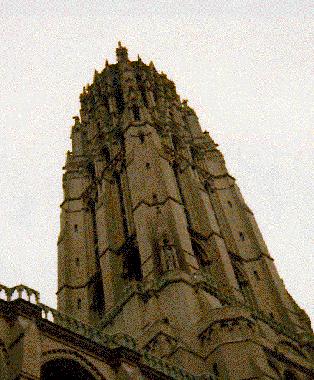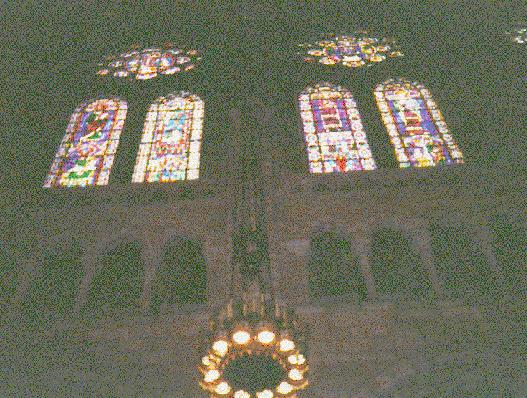|
The Riverside Church
By: James Retarides
()
|
490 Riverside Drive
New York, N.Y. 10027
Phone: 212-870-6722/20
Fax: 212-870-6800
|

|
Introduction:
In the early twentieth century, Christian congregations (in New York) and
those who supported them were torn between a modernist and fundamentalist
interpretation of the Holy Scriptures. The man who they looked to for answers
was a Dr. Harry Emerson Fosdick who preached passionately and became a
central speaker in the debate stemming from a sermon he gave on May 21,
1922 in the First Presbyterian Church in New York City, titled "Shall the
Fundamentalists Win?" Sparked by Fosdick's words, and led by John D. Rockefeller,
Jr., the body of members desired to create a church, beautiful beyond words,
and as great as the city where it would be erected. Dr. Fosdick was asked
to direct them towards this goal. Fosdick agreed, but only on these three
conditions:
- The only requirement for membership will be affirmation of faith in
Christ.
- The church must be interdenominational.
- The church must be a very large building with a more expansive ministry
in a neighborhood crucial to the livelihood of the whole city.
The decision was made; The Park Avenue Baptist Chruch, a stone's throw
away from Columbia University, Barnard College, Teachers College, Union
Theological Seminary, St. Luke's Hospital and the Jewish Theological Seminary,
was to be remodeled, and forged by the community.
The construction of the church was funded largely through the sale of church
properties on Park Avenue and donations made by opulent individuals, most
notably John D. Rockefeller, Jr. Rockefeller's mettle and leadership capabilities
enabled him to institute a building committee.
The Architecture
The building was designed by Henry C. Pelton and Charles
Collens. The two men rambled and searched through France and Spain for
the finest gothic architecture in attempts to assimilate it and recreate
it in a contemporary setting. Pelton and Collens decided to model the Riverside
Church after a 13th-century gothic cathedral in Chartes, France and the
cornerstone was laid on November 20, 1927.
The spirit of the congregation was challenged when (on December
21, 1928) the wooden scaffolding caught fire and spread throughout the
church's massive nave. A dark cloud of strain and halt of construction
loomed dark over the congregations enthusiasm and anticipation, but graciously,
they were invited to converge at the Temple Emanu-El by their newly found
Jewish friends. Construction was completed and the first mass was held
on October 5, 1930.
The Nave (and Chancel):
length: 215 FEET
height: 100 FEET
width: 89 FEET
capacity: 2,500
The floor maze in the chancel is an adaption of the maze in a cathedral
at Chartes, France. It is one of a select few such designs that remain
from the Middle Ages. It is not known exactly how the maze has religious
significance, but it is suggested that the maze may have been a reference
to Christ's path to Calvary (the Via Delorosa) or an alternative journey
for those who could not accompany the crusaders.
The stone carvings depict outstanding people from throughout history whose
lives have "exemplified some aspect of the life of Christ." A Christ carving
is central to each section of the screen.
Carvings-Section 1: Physicians
- Andreas Vesalius (1514-1564)
- Joseph Lister (1827-1912)
- Robert Koch (1843-1910)
- Hippocrates (c.460-c.377B.C.)
- Luke
- Christ the Physician
- Thomas Sydenham(1624-1689)
- Louis Pasteur (1822-1895)
Section 2: Teachers
- Thomas Aquinas (c.1225-1274)
- Henry Drummond (1786-1860)
- Thomas Arnold (1795-1842)
- Socrates (c.470-399B.C.)
- Christ the Teacher
- Desiderius Erasmus (1465-1536)
- Johann Heinrich Pestalozzi (1746-1827)
Section 3: Prophets
- Girolamo Savonarola (1452-1498)
- John Ruskin (1819-1900)
- Moses
- Christ the Prophet
- Isaiah
- John the Baptist
- Micah
- Elijah
- Elisha
- Amos
- Hosea
Section 4: Humanitarians
- Christ the Humanitarian
- Francis of Assisi (1186-1226)
- Elizabeth of Hungary (1207-1231)
- Valentin Hauy (1745-1822)
- Ann Judson (1789-1826)
- Abraham Lincoln (1809-1865)
- Booker T. Washington (1858-1915)
- Samuel Chapman Armstrong (1839-1893)
- The Good Samaritan
- Earl of Shaftesbury (1801-1885)
- Florence Nightingale (1820-1910)
- The Family Doctor
- Walter Reed (1851-1902)
- Edward Jenner (1749-1823)
- John Howard (1726-1790)
- William Booth (1829-1912)
- Mary the Mother of Jesus
- John the Disciple
Section 5: Missionaries
- Philip the Evangelist
- Stephen (c.977-1038)
- John Eliot (1604-1690)
- Christ the Missionary
- William Carey (1761-1834)
- Augustine (354-430)
- Francis Xavier (1506-1552)
- Robert Morrison (1782-1834)
- Adoniram Judson (1788-1850)
- Paul
- David Livingstone (1813-1873)
Section 6: Reformers
- George Fox (1624-1691)
- John Knox (1505-1572)
- John Sesley (1703-1791)
- John Wycliffe (c.1324-1384)
- Christ the Reformer
- Martin Luther (1483-1546)
- John Calvin (1509-1564)
Section 7: Artists
- John Greenleaf Whittier (1807-1892)
- Fra Angelico (1387-1455)
- John Milton (1608-1674)
- Giovanni Palestrina (c.1524-1594)
- Leonardo da Vinci (1452-1519)
- Christ the Lover of Beauty
- Michelangelo (1475-1564)
- Johann Sebastian Bach (1685-1750)
The Pulpit:
The wood canopy above the pulpit emulates the architectural theme or motif
of a medieval cathedral. Each canopy of the pulpit and the lectern display
a distinct property of medieval design. Each of the three major parts of
the pulpit were carved out of 3-ton chunks of stone. Around the supporting
column there are five statues of prophets inside of the canopies, they
are: Anna, Amos, Isaiah, Hosea, and Miriam from left to right. The ten
canopies along the pulpit rail represent the classic cathedrals: Amiens,
Toulouse, Albi, Rouen, Chartres, Tours, Countances, Rheims, and Notre Dame.
The oak choir stalls' theme is "Praise of God." An artist rendering of
the "elements and living things" called by the psalmist in Psalm 148 is
carved on the ends of each stall. Similarly, Psalm 51 and its opening words
are the inspiration for the names on the Misericordi. The misericordi were
modeled to manifest a classic ritual in which monks used to sit and rest
while reciting the psalms.
The pulpit itself is in memorium of Cornelius Woelfkin, the pastor of the
previous Park Avenue Baptist Church who helped organize the Riverside Congregation.
On the face of the First Gallery there are four stone statues, Moses, Amos,
David and Gideon.
The chancel rail delineates twenty of the common interests, ceremonies
and other activities exhibited by those in congregation. They are (as Published):
- Prayer- The Publican and the Pharisee
- Prophecy- Isaiah, the lion and lambs
- Evangelism- Paul on Mars Hill
- Ministry- Moses and the Commandments
- Ordination- Candidate and two elders
- Dedication- Parents, child and minister
- Memorial- Woman at the tomb
- Baptism- Charlemagne, bishop and knight
- Communion- Christ with two Apostles, bread and wine
- Immortality- Christ and Mary Magdalene in the garden
- Creation- God and Adam
- Hymnody- Angel trio
- Marriage- Pastor and couple
- Festival- Triumphal entry
- Friendship- David and Jonathan
- Patriotism- Joseph gives grain to his people
- Sacrifice- Mary anointing the head of Christ
- Forgiveness- Christ and the woman taken in adultery
- Nw Testament- The Sermon on the Mount
- Old Testament- The Ark of the Covenant
The Windows:
 |
The windows of The Riverside Church may very well be its
greatest asset. It is the crowning jewel to the churches glorious architecture.
During the morning, the chancel fills with radiant light as the windows
create a rainbow semblance and a heavenly effigy. Possibly the most lustrous
are the five apse clerestory windows above the chancel. They are titled:
Apostles, Jesse, Heavenly Host, Worship and Praise. |
The Carillon :
In memory of his mother, John D. Rockefeller Jr. donated the Carillon to
The Riverside Church. It consists of 74 bells (all solid bronze), the largest
is the 20-ton bourdon and the smallest is a 10-LL.B. treble bell. The total
weight of all the bells is over 100 tons. The bourdon is the largest tuned
and cast bell in existence. 53 bells of the Carillon were installed by
Gillette and Johnson Foundry of England in 1925 making it the largest carillon
in the world. This made it the only carillon in the world that could surpass
five musical octaves and achieve a bourdon of pitch C.
The Laura Spelman Rockefeller Memorial Tower reaches 392 feet into the
sky. The open-air observation platforms allow a 360-degree view of the
city and adjacent Hudson River.
The Paintings :
In The Riverside Church hang three paintings by Heinrich Hofmann donated
by John D. Rockefeller , Jr. "Christ in Gethsemane" (1890), "Christ in
the Temple" (1871) and " Christ and the Rich Young Man" (1889). Another
was a gift from Elise A. Drexel called "Christ's Image."
The Tapestries :
There are four main Tapestries inside of The Riverside Church. One is a
panel of early 16th-century "Franco Flemish mille Fleur tapestry" which
reveals active birds, rabbits and deer in a resplendent field with a plethora
of flowers. Another tapestry of the same genre portrays a unicorn with
other graceful animals such as birds and rabbits. It was given to the church
by the daughters of a Mrs. Edward L. Ballard in her praise. King Clovis
I is portrayed in a religous ceremony from a Flemish Transitional Tapestry
dated circa 1500. Lastly there is a French Renaissance Tapestry dated circa
1600 limning a feast . This tapestry as well as the latter were a gift
to the church from Edward and Margaret Green.
Conclusion :
The Riverside Church is located at one of highest points above sea-level
in New York City. Its surrounding speak volumes of the poverty and resources
of Harlem. It is located nearby many religous and educational institutions
yet also neighbors some of the most impoverished neighborhoods in New York.
It is in many ways equidistant to both our ideals and fears. A long time
ago the citizens of this city wanted to make it a city upon a hill and
in many ways, they have. The Riverside Church is on top of that hill looking
over us, after us.
Bibliography
- Coffin, Jr., William, The Riverside Church in the City of New York,
(New York, Sterling Roman Press, 1978)
Links [All on Medieval New York main page]
- Cathedral of St. John the Divine
- Trinity Church
- St. Patrick's Cathedral
- St. Vincent Ferrer
The Internet History Sourcebooks Project is located at the History Department of Fordham University, New York. The Internet
Medieval Sourcebook, and other medieval components of the project, are located at
the Fordham University Center
for Medieval Studies.The IHSP recognizes the contribution of Fordham University, the
Fordham University History Department, and the Fordham Center for Medieval Studies in
providing web space and server support for the project. The IHSP is a project independent of Fordham University. Although the IHSP seeks to follow all applicable copyright law, Fordham University is not
the institutional owner, and is not liable as the result of any legal action.
© Site Concept and Design: Paul Halsall created 26 Jan 1996: latest revision 12 April 2024 [CV]
|